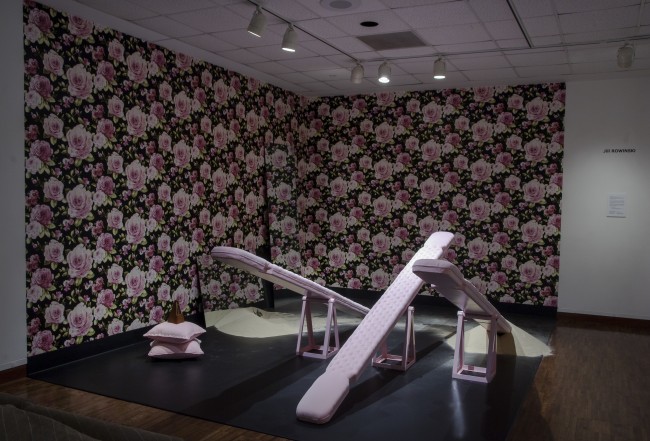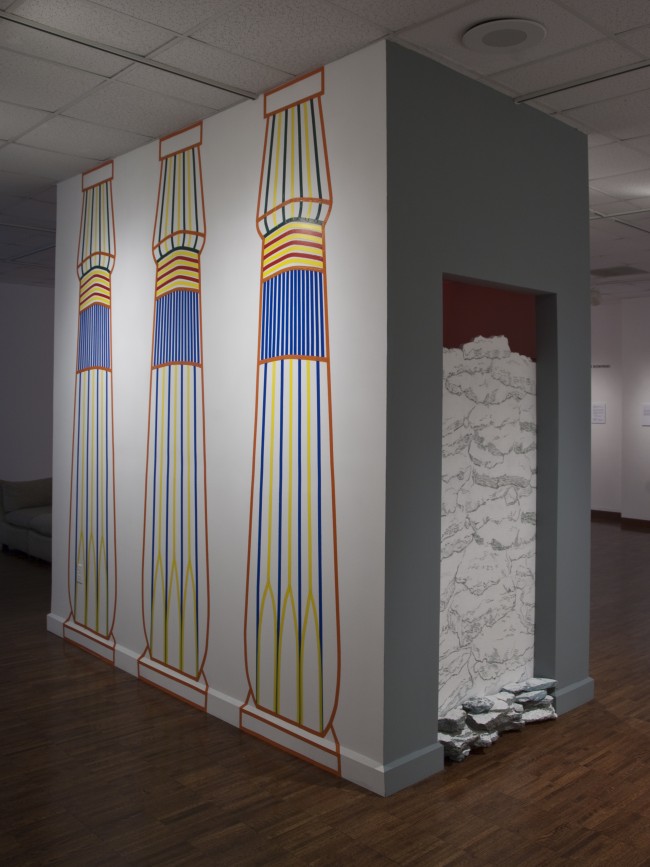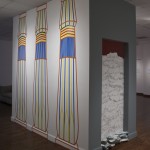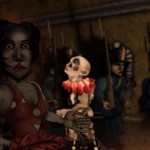Singing for Myself: Seeing Opera
Alice F. and Harris K. Weston Art Gallery
June 14–August 31, 2013
By Jonathan Kamholtz
Mr. Sousaphone, the main character in Jay Bolotin’s remarkable 22-minute video “Kharmen,” makes it back home after a long and dangerous and partly hallucinatory urban trek. He puts an old vinyl—or possible even shellac—version of Carmen on his turntable. In his eye, or in his imagination, or perhaps both, a miniature, almost puppet show version of the opera begins, and Carmen is singing her great mischievous “Seguidilla.” We see a puppet Don Jose and a puppet Carmen as Mr. Sousaphone might see them, and we see the huge, blank face of Mr. Sousaphone looming over the tiny stage as the characters might see him. And then, in a moment of inspired magic and madness, Mr. Sousaphone is briefly miniaturized and wanders through the set with Don Jose and Carmen. For just a moment, he’s really—I mean really—into the music.
Carmen sings her seductive aria about the great times to be had at the tavern of her good friend Lillas Pastia in the hope that Don Jose will allow her to escape from the soldiers who have arrested her. When Don Jose tries to turn off the flow of her temptation, he tells her to leave him alone and stop singing, to which she answers “I am not talking to you, I am singing for myself.” Though these are both highly dubious assertions on her part, they raise interesting questions about an opera and its audience, questions partly raised as well by the artists in the show. For all its desire to draw an audience in, there is something exclusionary about opera. It’s not always easy to find a way in.
Peter Haberkorn’s envisioning of a space that corresponds to Britten’s Billy Budd is more literally a performance space (complete with a piano tucked in the corner). Its seven sails handsomely sculpt the air above the gallery’s marble floor, and the combination of opaque cloth and clear plastic create a lovely space for seeing and hearing opera. A rope with a noose at the end makes it fairly specific to Billy Budd, and the installation is more literally illustrational. It is also the only installation in which one could imagine oneself as the performer of the opera and not just the consumer. I could be singing for myself.
Though story may be at the heart of opera, another thread of the show was the resistance to narrative. Denise Burge made an eight-foot tall rendition of Ruxandra Donose as Octavian, the Marschallin’s young lover (though clearly, in Burge’s portrayal, not too young). The work seems to be in part an homage to the artifice of opera, having a handsome, nearly fifty year old woman dressed for her trouser role as the young man, all done in painted fabric to remind us how much of an opera’s drama is made out of costumes.
Goldman’s own piece, “The Last Act,” is also a reminder of how mediated an operatic experience can be. On one wall on the outside of a box he has created, he has mounted a full-sized photograph of an Egyptian pharaonic monument. On another, he has rendered in bright tape three ancient columns. On a third, he has painted a rock wall with loose, evocative brushwork. From inside the box, just over the top of the painted rock wall, we hear a taped loop of the exquisite final ten minutes of Aida, as the heroine expires in her walled tomb. The work is made up of a combination of homages: to orientalism, to the super clean lines of pop art’s draftsmanship, to the soft and alluring brushwork of centuries of painting. It is a reminder that artwork’s home address is in the world of art. But “The Last Act’s” inner sanctum—which consists of the hearing of the opera rather than the seeing of it—is a mysterious experience, walled off from its audience, something we treasure but can barely make out.
The extreme end of reducing the narrative element of opera may have been in Howard Wells’s digital pinhole photographs. In his artist’s statement, Wells writes that “I listen to opera all the time, mostly arias, mostly at home…. Over the past 40 years my interest has moved from following the story in the libretto to the emotions expressed.” Wells’s works are lyrical and out of focus versions of mostly recognizable objects or locations. We are very good at decoding. Some are sort of still lifes, some are sort of landscapes, and only a few are unidentifiable. It is a forceful way to deny objects their connection to narratives, and seems in line with with his description of switching interest in opera from a libretto to arias and emotions. I would be harder put to say just what emotions are being captured or communicated, but perhaps that has more to do with what and how I decode, and what my interpretive inhibitions are.
Rebecca Seeman’s “cosmologic” is a wall sculpture made up of a cloud of 128 small aluminum discs, with a much smaller arrangement on the wall adjacent. It seemed an homage to Galileo’s world with the drama excised—a stable and elegant view of the heavens as they might have been perceived either before Galileo or after him, but not during the time of his controversial reordering of our celestial context.
Another thread in the show was the assumption that part of the experience of opera is that it represents an investment of time on the part of an audience. In contrast to Seeman’s piece, Deborah Brod’s “For Galileo’s Daughters/Sun” asks us to give time to explore a back-story behind Philip Glass’s opera. While an installation of hanging fabric is animated by a small fan that is powered—though, to be fair, only rather sporadically—by solar batteries, the audience puts on headphones to hear a reading of translations of letters to Galileo from this daughter, who changed her name to Maria Celeste in his honor. The domesticity of the letters is pretty intense. They are marked by a love between daughter and father that seems a little over the top by 21st century standards: “I come to the end of this letter without ever coming to the end of my love for you.” There is much discussion of the sufficiency of his linens and baked goods. It was interesting that the installation preserved the private quality of the one-sided correspondence. One felt a little like an eavesdropper or even a wire tapper, immersing oneself via headphones for some modest amount of time in a sequence of letters with no apparent beginning or end.
At almost 33 minutes, Joey Versoza’s video “Goose Opera: A Mall Tragedy” required the largest commitment of time from its audience. Disclosure: I didn’t make it through much more than half. In the parking lot of a fortress-like shopping mall, geese come and go, or stand still. People—mostly women—pass in and out of the mall and garbage floats by on the breeze. The image is sometimes right side up and sometimes sideways. It’s a lot to ask someone to watch. The experience of watching it is made more dense in some ways by reading that Versoza was listening to Don Giovanni while he created the piece, and made at least a little less dense, in the context of this show, by reading in his statement that “My relationship to opera is a distant one, but its aesthetic nature is not lost on me entirely.” It is fair to say that “Goose Opera” is not my idea of Don Giovanni or my idea of tragedy or even my idea of a mall, and the artist’s claim that it is partly about “Midwest consumerism” is hard to support. Perhaps the core of the piece is in the creative tension latent in his phrase “aesthetic nature.” What is still natural about the artificial world, and in what ways can the aesthetic be seen to intersect with the apparently random movements of some of nature’s citizens?
Bolotin’s “Kharmen” is an incredibly accomplished and extremely apt piece for this show. Opera is alive for Bolotin; though it is mysterious, he is not mystified by it. In 1990, he wrote an opera, The Hidden Boy. His new video represents a deep critical engagement with opera. In it we see Carmen through the eyes of a paradigmatic Bolotin character, Mr. Sousaphone, who is dressed in a striped coat (a bathrobe? a clown suit? a concentration camp inmate’s uniform?) and carries a phone that will sometimes double as a microphone trailing a coiled cord that is not attached to anything. The Carmen that haunts the video is not the white hot passionate display that some recent productions capture; Bolotin’s Carmen is both extravagant and reserved. In his connection to Bizet’s Carmen, Mr. Sousaphone is drawn to an emotional intensity that could relieve his alienated drudgery, but which is in danger of shattering if he gets too close to it. Mr. Sousaphone illustrates Heisenberg; to observe a thing is to change it. He is a voyeur and an audience for an opera is an assembly of them.
Bolotin’s title is an homage to Daniil Kharms, a Soviet modernist and absurdist who moved in some pretty fancy cultural circles in post-revolutionary Russia. Kharms provides the text that upholds the video’s belief in the mystery of materialism: under some circumstances, we are told, words can “become a thing, and can take them off the page and throw them at a window, and the window will break.” In the video, windows shatter and stage sets explode.
Mr. Sousaphone is obsessed with Carmen, as was Bizet’s hero, the hapless Don Jose. Their tragedies are related, though not identical. Neither can fully enter the world that obsesses them, though Don Jose makes a better go at leaving his former life behind than Mr. Sousaphone does. Mr. Sousaphone’s world is made of inhospitable streets inhabited by dogs and rats. He hopes that opera will be his Kabala: a mystic key that gives some status to the interpretation of mysteries. But in the end, it doesn’t. Bolotin’s Carmen is not singing to herself—the opera is not singing to itself—but it would be easy to overestimate the good that comes to an audience from being exposed to the singing. Bolotin has created a dispassionate tragedy of “Kharmen” in conversation with Bizet’s passionate tragedy of Carmen.
- Rowinski-Jill-Today-Tomorrow-the-Day-after-Tomorrow-2013-view-1a
- Goldman-Stewart-The-Last-Act-mixed-media-installation-with-light-and-sound-2013-view-1
- Bolotin, Jay – scene from Kharmen, 2013, digital video
- Bolotin-Jay-Kharmen-film-still-6-2013-digital-video











